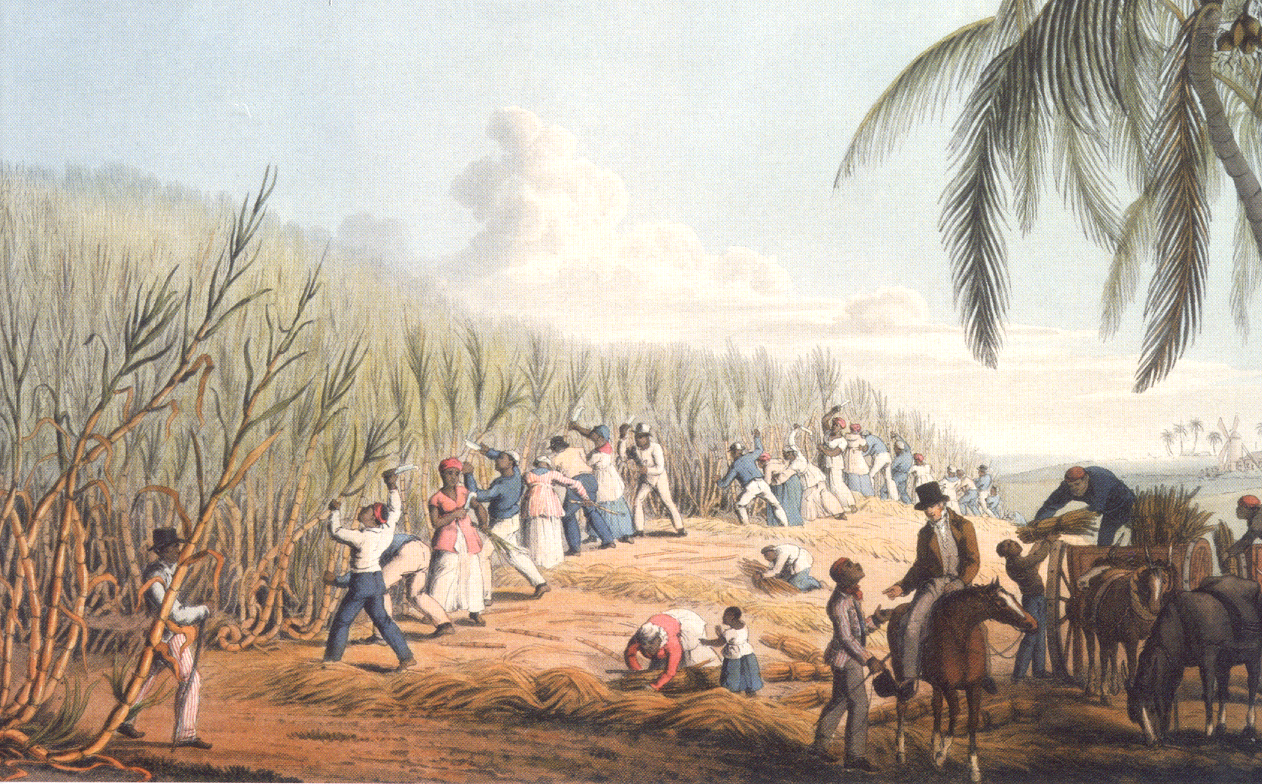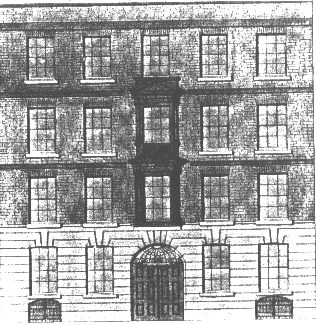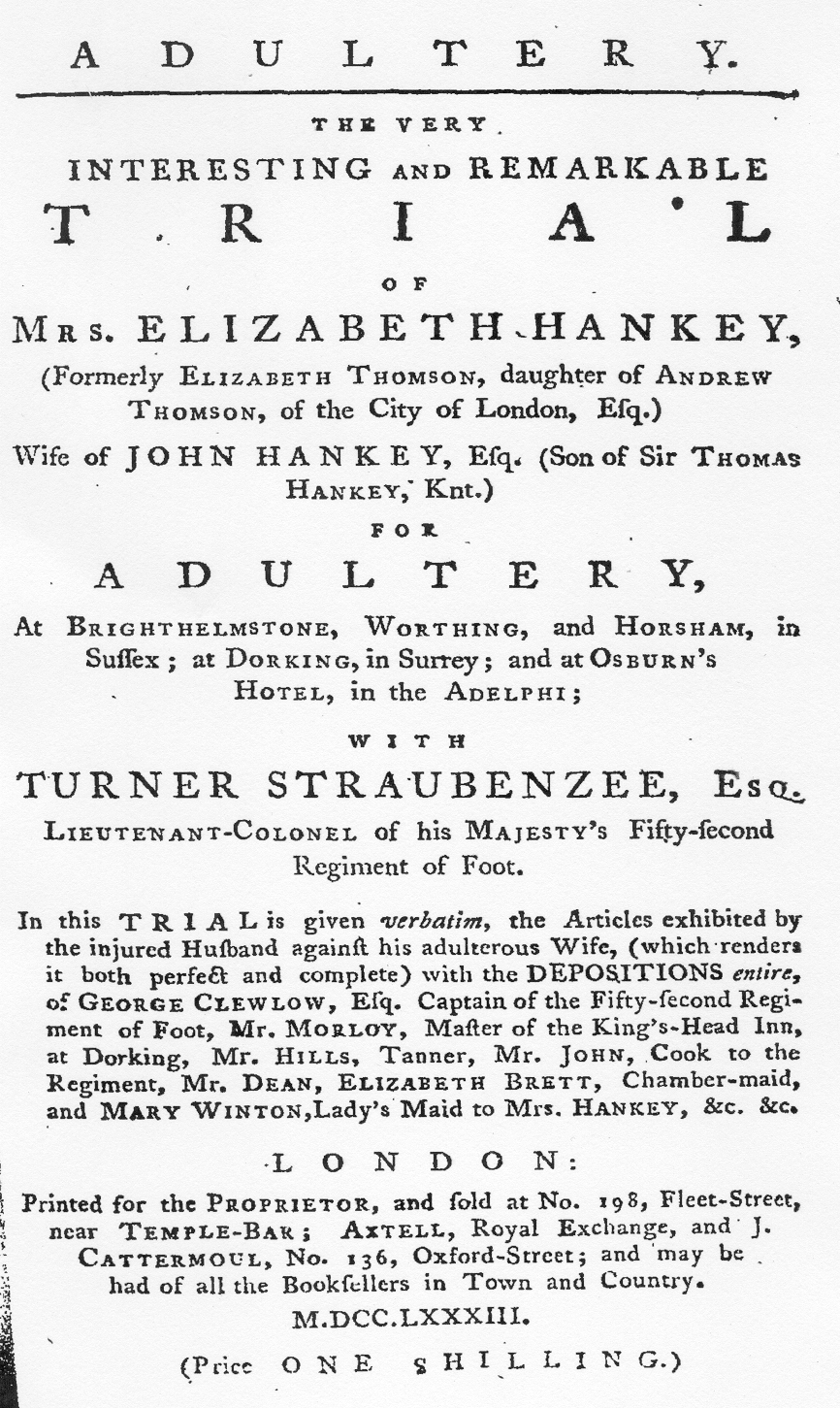Navigation: Hankeys of Churton > John Hankey > Robert Hankey > Robert Hanky > Thomas Hankey > Henry Hankey > Thomas Hankey >
John Hankey (1741-1792)
The second surviving son of Sir Thomas Hankey and Sarah nee Barnard, John Hankey was born on 6 Sep 1741, possibly at Clapham, and was baptised on 30 Sep at St Dionis Backchurch.
John was married on 9 Sep 1769 at St Martin Outwich to Elizabeth Thomson, by whom he had four sons:
1770-1807 |
|
1773-1855 |
|
1774-1855 |
|
Charles |
1776-1816 |
As a young man, John Hankey entered the family firm in Fenchurch Street. Alongside its main business of banking, in the middle of the eighteenth century the firm was also actively trading in the West Indies, and records from Spanish Town, then the capital of Jamaica, show three mortgages in the name of Hankey dated 1754.
Into the picture at this stage comes Pierr; of Dutch origin, he was born in 1691 in Groot Drakenstein, South Africa, the son of the founding minister of the Huguenot settlement in the Cape. In 1702 his family had returned to Holland, and he served as an apprentice with the mercantile house of Fizzeaux and Co until 1708.
In 1713 he came over to London with a letter of introduction from Fizzeaux and Co to Henry Hankey, and so began a happy and profitable relationship between the two families.
Simond was naturalized in 1717. He set up his home in Nicholas Lane, just a stones throw from Fenchurch Street, and began trading principally in sugar from Santo Domingo, Grenada and Carolina. He prospered socially as well as financially, and records show that in 1728 he entertained at his home Voltaire, who arranged ‘for the in quarto edition of his Henriade to be delivered to Messrs Simond et Benezet, merchants by the Royal Exchange, so that the book might be delivered to any subscribers who sent in their receipts.’
The operations of the firm of Simond & Hankey [in Santo Domingo] may be followed in some detail from its ledger for the years 1792-99, preserved by its successor, Thomson Hankey & Co. Simond & Hankey had dealings with the émigré planters early in 1793, even before the British troops had effected the first landing in the colony.
The ledger of Simond & Hankey cited above contains enough information to make one regret the more the destruction of that firm’s old correspondence, which became necessary a few years ago [in 1928] when the present firm moved from its eighteenth century location in Mincing Lane.

Cutting cane on a West Indies plantation
Over a period of more than fifty years the Hankey and Simond families became close friends and were engaged in joint enterprises for West Indian trade. So it was not unnatural for Peter Simond, whose son had died in infancy and whose daughters had husbands who were not interested in trade, to seek advice on the future of his business from the Hankey family.
In 1758 John Hankey, the second of Sir Thomas’s three sons, was apprenticed to Peter Simond, merchant of Austin Friars, for a premium of £700. It was agreed in 1764 that John Hankey, then aged 23, should go into partnership with Peter Simond and merge the West Indian side of the Hankey firm, and on Peter Simonds death his business should pass to the Hankey family.
This partnership thrived and Simond & Hankey soon had three ships sailing the Atlantic. Records show that they also had interests in other ships connected with Colonial trade. In 1770 there was a Petition from Simond & Hankey to the Commissioners of Trade and Plantations asking leave to export military stores to Havre le Grace by way of Ostend on board the Marie Aufret, for French African trade.
On 3 Apr 1781 there was another request to the Privy Council for a pass to protect the Dutch ship Adrichon on her voyage from Brest to Amsterdam, as she had already been attacked by an English privateer and re-taken by a French frigate on her way from Grenada to Amsterdam.
Peter Simond’s estate in South Carolina was confiscated in 1782. Simond & Hankey are also on record as having properties and mortgages in Grenada, Jamaica and Antigua, and as having acted on behalf of those willing to lend money on mortgages in these islands. On 23 Apr 1783, Simond & Hankey subscribed £30,000 to a loan floated by the Bank of England - but although this shows evidence of healthy profits from the company, an even larger amount of £100,000 was subscribed by the parent firm of Thomas Hankey & Co towards the same loan.
Peter Simond, who was John Peter Hankey’s godfather, died on 23 Nov 1785 at Bishopsgate Street aged 94, leaving his estate equally to his daughter Lady St John of Bletsoe, his son-in-law Sir John Trevelyan, Bt., and to John Hankey as his adopted son.
So well endowed was the daughter of Peter Simond, London merchant and West Indian plantation owner, that in 1755 she secured the hand of the eleventh Baron St John; and no doubt her dowry of £20,000 was to the Baron not the least of her attractions.
His will gives a comprehensive account of his estate: All my sugar plantations and houses, buildings, sugar works, mills, lands, tenements, negroes, slaves, plantation utensils, live and dead stock and all my parts and shares in the same, situated and being in the island of Grenada and elsewhere in the West Indies. In 1783 John Hankey had estimated his fortune at between £45,000 and £60,000, an amount which must have increased considerably after Peter Simond’s death.

7 Mincing Lane
John Hankey did not bring back to Thomas Hankey & Co the West Indian trade which had been built up; Thomas Hankey & Co was a substantial bank at this time and it may not have seemed practical to merge the two businesses at a time when feeling against slavery was mounting. In the early nineteenth century, however, three of the partners of Hankey & Co owned the Arcadia estate in Jamaica, and were buying slaves as late as 1827.
7 Mincing Lane
John Hankey’s premises were at 7 Mincing Lane, and the family home was on the upper floors. In 1790 John Hankey built a house named Hill House on eleven acres of land at Clay Pit Lane on the north side of Streatham Common, not far from his childhood home at Clapham, bought from the Duke of Bedford for £1800. Soon after his death two years later, his son John Peter Hankey sold the property by auction at Garroway’s Coffee House, Exchange Alley for £5076.
John Hankey died on 29 Aug 1792 at Tunbridge Wells and was buried on 7 Sep at Streatham; his will made on 4 Aug 1773 and a codicil were proved at London.
The register of the French Church in Threadneedle Street contains the following entry:
*BIGNOU - 22 Sep 1775 Jean Jaques - f d’Henry B. et Priscille Smith.
P. Jean Proye. M. Catherine de Marais.
*On a slip of paper, pasted on f.20 (1729) is the following:
Le vendredy 22 Sept 1775, fut batise Jean Jacque Bignou
Endorsed ‘Mr [John] Hankey, Mincing Lane, Fanchurch Street.’
Elizabeth Hankey nee Thomson (1751-1785)
Elizabeth, baptised on 26 Sep 1751 at St Peter-le-Poer, was the elder daughter of Andrew Thomson and Harriet nee Buncombe. Andrew Thomson was a Russia merchant, living in the City and at The Cedars, Roehampton Lane. His second daughter Maria was married in 1777 to Sir Joshua Vanneck (created Lord Huntingfield in 1796), of Roehampton House and Heveningham Hall.
During the eighteenth century, all trade with Russia was controlled by the Russia Company, which levied duties on all goods imported into Britain and provided escorts for the twice-yearly convoys which sailed from the Thames to the Baltic. Trade with St Petersburg increased thirteen times between 1700 and 1792, and by the turn of the century there were some five hundred ships a year making the voyage. Andrew Thomson had chosen a rapidly expanding business to get involved in, and his success enabled him to support both the Marine Society and the Foundling Hospital and to become a governor of both institutions.
What we also know for certain is that when the Maritime School was set up in Chelsea in 1775 for the purpose of educating future naval officers, Thomson joined the committee, and that his name also appears in a list of subscribers to the patriotic fund which opened when the War of American Independence began. Much less clear is the precise nature of his relationship with John Julius Angerstein, who was born in St Petersburg in 1825 and moved to London in 1849 to start work as a clerk in Thomson’s firm. We can easily dismiss as fiction the suggestion that Angerstein was the result of an affair between Thomson and Catherine the Great, on the grounds that she was just seven years old when Angerstein was born. More difficult to refute are the persistent rumours that Thomson was the ‘great Russia merchant’ who fathered a son by the notoriously promiscuous Elizabetha Petrovna who was Tsarina from 1741 to 1762. The most colourful story has Angerstein, when a babe, being let down in a basket from a window in the Empress palace at St Petersburg, and endowed by his imperial mother with a fortune of 100,000 roubles in gold. That would certainly help to explain how he went on to become one of the most celebrated financiers and art collectors of his age. Correspondence survives between Angerstein and Thomson, concerning the arranging of insurance for a ship which had just departed from Lynn Regis, and it is certainly the case that Thomson was at the very least a faithful sponsor of Angersteins’s endeavours. Angerstein’s picture collection would eventually form the nucleus of London’s National Gallery.

In 1781 Elizabeth Hankey took a house at Brighton for the sake of her health, while her husband, who suffered from gout, was often detained in London on business. While there, Elizabeth met Turner Straubenzee, lieutenant-colonel of the Fifty-second Regiment, and eloped with him to Dorking. It was said that the elopement cost Turner Straubenzee £10,000, which he could not pay, so he and Elizabeth Hankey fled to Scotland until 1783, although he was still in command of his Regiment. The regiment was then posted to India to take part in the Second Mysore War against Tipu Sultan. Elizabeth accompanied Turner Straubenzee to India, and bore him a son.
Meanwhile John Hankey had sued Elizabeth for divorce, which was granted on 1 Feb 1783 on condition that neither remarried in the lifetime of the other. John also obtained £500 damages (compared with the ruinous £10,000 originally said to have been demanded) and £60 costs. News of the divorce arrived in India, and on 25th Aug 1783 the couple (ignoring the ban on re-marriage) were married at St Thomé, Madras. Elizabeth was married in the name Miss Elizabeth Thompson [sic]. She died on 23 Oct 1785, probably in India, having had a son who had also died.
Turner Straubenzee made his way back to England ‘across the desert’ via Basra, Baghdad and Constantinople in 1787, accompanied by a Portuguese manservant. He took a second wife on 28 Apr 1788 at Wakefield, in his native county of Yorkshire. Financial troubles followed Col Straubenzee, and he was relieved of his command on 11 Jun 1789 after delay in settling the men’s pay accounts following the Poonamalee Mutiny in the East Indies. He was married a third time on 19 Jan 1795. He died on 5 Apr 1823 aged 75.
Extracts of a letter written by Elizabeth Straubenzee at Poonamallee, India on 29th January 1784 to her sons John Peter Hankey and Thomson Hankey. The letter is 3pp., 4to. Bifolium. 58 lines of text. On worn and aged paper, with loss to eight lines as a result of the breaking of the seal. Addressed, with remains of red wax seal, on reverse of second leaf, to 'John Peter Hankey Esqr | Bishopsgate street | London'.
The letter begins: 'I was in great hopes my dear Children to have met by this time with some little thing to have sent you, but such is the stupidity of this Country they neither make things themselves or have the sense to bring them from other countries. A China Ship came in a few days ago. I went to Madras desirous of finding some Crackers or Colours for you, the Captain had never thought of bringing either, not even an Ivory ship for Thomson. It seems they carry such things to the London Market but wisely suppose the good folks here do not abound in Taste, & are therefore contented if they get some bad tea, ugly silks, & plenty of Sugar candy. However by the first ships going from hence I shall try to get some things sent to me.' She discusses her health 'in this climate', and 'the manner of travelling in this strange place': 'I am carried in a large tea tray with a cover over the top. & full of pillows by ten men. They take it four at a time & relieve one another without stopping. They go about five miles an hour sometimes more. & will carry you forty miles a day. In this machine which they call a palanquin you sleep at night, & indeed it is as good as the beds in one’s home for they are very seldom more than a cane couch'. Many houses, she reports, 'have roofs like a barn & the rats, birds, bats, & lizards are very friendly & inhabit the same room always'. She describes 'some races' which 'lasted three days', in 'nine or ten tents in a very pleasant field near the spot by which means & an excellent band of musick we made the time pass pleasantly'. She continues: 'I wait with no little impatience for a Letter from my dearest boys. I long to know how they do, where they are & if the learning goes on well. The more blockheads I see the more anxious I am they should profit by the opportunities they have of being otherwise'. The conclusion of the letter has suffered loss as a result of the breaking open of the seal. In it she refers to 'your Aunt Agnes', and assures her sons that they are 'never an instant' out of her thoughts: 'I count the hours till my return'. She signs 'your ever aff’ate Mother | Eliza Straubenzee'. In a postscript she refers rather stiffly to her former husband: 'Make my best Compts to Mr Hankey.'
Richard M Ford, antiquarian bookseller, 2015